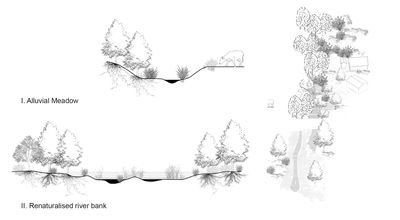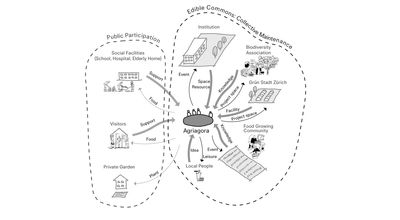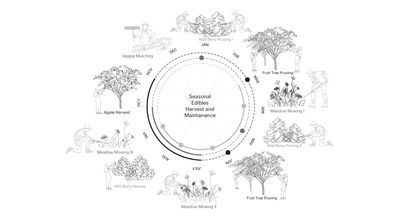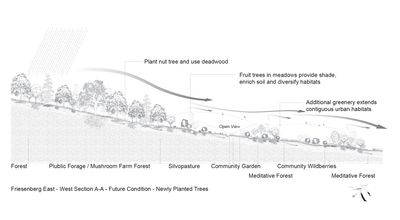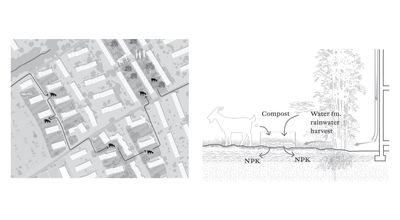Territorial Constitution: Six Agroecological Typologies for the Zurich Metropolitan CoreHiroaki Anamizu, Khyati Andrapiya, Erze Dinarama, Manson Fung, Antonia Gerogianni, Gautham Ramesh, Francis Schoups, and Diana Zarnescu
The Territorial Constitution for the Agroecological Zone in the Zurich Metropolitan Core aims to present guidelines for a future vision of urban agriculture in Zürich. It consists of a map, a text describing the articles of the constitution, and supplementary diagrams.
Our departure point is the combined Erholungs- and Freihaltezones, within which urban agriculture is currently embedded, alongside cemeteries, sports facilities, allotment gardens, parks and different types of protected green areas. Currently, these zones circle the Zurich hillsides, between the protected forest and urban settlement. The city of Zurich is expecting 25% growth in the next 15 years (2040), therefore the open or “green” spaces are increasingly under pressure as recreational areas for the growing population. The hills Uetliberg, Zürichberg, Hönggerberg, Käferberg and Adlisberg already provide important recreational spaces and facilities. The questions of local food production and involving urban residents in different stages of this process also have a strong impact on the development and use of the Agroecological Zone.
Our Agroecological Zone gathers together the fragmented current uses in the zone mentioned above, and strengthens the zone’s agricultural character. The zone will include specific typologies that are able to connect existing plus new potentials and situate imagined future uses. The Agroecological zone is differentiated according to sun, water, soil, social structure, existing trees, gardens, farms and institutions, and extends its fingers into the urban fabric, linking up waterways, treelined avenues and biodversity corridors. Six new typologies are proposed that serve to secure a place for agriculture, and interweave agriculture not only into the local food chain, but also into the cultural, recreational and ecological life of the Metropolitan Core. In addition to the six typologies, the constitution therefore upholds several fundamental principles that concern the ecological maintenance and wellbeing of the landscape and city as a whole.
1) Riparian Sanctuaries
Areas of water in Zurich are currently protected to differing degrees and through different ordinances and conventions, for example the Swiss Water Protection Ordinance (1998) for surface and underground waters, and the international RAMSAR convention ratified in Switzerland in 1976 and the Federal Environmental Protection Act (1983) for wetlands. Aquatic habitats are some of the most deteriorated in Switzerland with over 50% of the watercourses in a degraded condition. This typology aims to connect different water areas, restore natural habitats and therefore also improve biodiversity, and improve local microclimates.
2) Agri-Agora
An Agri-Agora is a new community meeting-place for exchange about food and growing food in an urban context. It is a place to celebrate food and hosts seasonal markets and a range of activities and events. The Agri-Agora is the central meeting place for the Agrarian council, made up of representatives from food-growing communities, living labs, institutions such as FIFA, and local inhabitants.
3) Edible Gardens
Gardens and green spaces in the Agroecological Zone are highly differentiated according to ownership and types of use. The aim of the edible gardens is to strengthen and stitch together existing and new gardens into a landscape of both public and private edible wild plants and to promote a public connection to food. In denser urban areas or private residential areas, public streets can become part of the system.
4) Commonwoods
The Commonwoods is a new type of forest encompassing the protected forest, agricultural orchards and urban trees under one collaborative management concept among foresters, farmers, community gardeners and urban arborists. Through the Commonwoods, an integrated practice for maintaining and extending forest functions throughout different city regions is developed.
5) Regenerative fields
Urban expansion in Zurich has resulted in the alienation of city residents from agricultural areas, and a lack of contact to animals or their potential source of food. But in Zurich, Lausanne, Paris, Madrid and Davis, California, for example, small flocks of sheep or goats have already been introduced back into urban areas to maintain grass, assist in fire prevention, and forming a micro-sector of meat production. A form of transhumance, also called controlled migration of livestock, this practice is managed by the Urban Shepherd and is the inspiration for this typology.
6) Urban Shepherd Zone
Urban expansion in Zurich has resulted in the alienation of city residents from agricultural areas, and a lack of contact to animals or their potential source of food. But in Zurich, Lausanne, Paris, Madrid and Davis, California, for example, small flocks of sheep or goats have already been introduced back into urban areas to maintain grass, assist in fire prevention, and forming a micro-sector of meat production. A form of transhumance, also called controlled migration of livestock, this practice is managed by the Urban Shepherd and is the inspiration for this typology.

